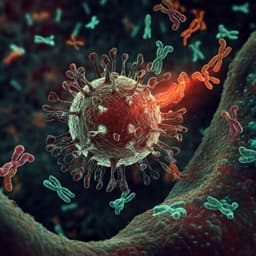
Veterinary Science
ChAd155-RSV vaccine is immunogenic and efficacious against bovine RSV infection-induced disease in young calves
R. D. Jong, N. Stockhofe-zurwieden, et al.
This innovative study by Rineke de Jong and colleagues explores the potential of the ChAd155-RSV vaccine candidate, demonstrating its ability to generate significant immune responses and protect calves from RSV. A single dose was remarkably effective, paving the way for future infant vaccinations.
~3 min • Beginner • English
Introduction
Respiratory syncytial virus (RSV) is a leading cause of lower respiratory tract disease (LRTD) in infants, with an estimated 33.1 million annual episodes of RSV-associated acute lower respiratory infection in children under 5 years and substantial hospitalization and mortality, especially in low- and middle-income countries. Past vaccine efforts were hindered by enhanced respiratory disease (ERD) observed with the formalin-inactivated RSV vaccine in the 1960s, highlighting the need for candidates that induce high neutralizing antibody titers, Th1-biased CD4+ T cell responses, and CD8+ T cell responses. Adenoviral vectors, particularly chimpanzee adenovirus (ChAd) vectors with low human seroprevalence, can induce robust humoral and cellular immunity. ChAd155-RSV encodes a secreted RSV F protein for humoral responses and intracellular N and M2-1 proteins intended to elicit CD8+ T cell responses. This study evaluates the immunogenicity, safety (with respect to ERD), and efficacy of ChAd155-RSV in young calves using a bovine RSV (bRSV) challenge model that mirrors severe pediatric RSV disease, including exploration of short and long durations of immunity and the impact of pre-existing (maternal-like) RSV antibodies.
Literature Review
The authors review evidence that FI-RSV vaccination historically caused ERD characterized by Th2 bias, high ratios of non-functional antibodies relative to neutralizing antibodies, and lack of CD8+ T cell responses. They highlight that viral-vectored and nucleic acid-based platforms, by driving intracellular antigen expression, tend to favor CD8+ T cell induction and Th1-skewed responses, potentially mitigating ERD risk. ChAd vectors have shown acceptable safety and immunogenicity in humans for multiple pathogens (including RSV and SARS-CoV-2). Preclinical data suggest no single animal model perfectly predicts human infant outcomes; however, the calf bRSV model recapitulates severe pediatric disease features and can reveal ERD signals, making it valuable for translational assessment. Human and bovine RSV F proteins share >80% amino acid identity, supporting cross-reactivity. Prior clinical data indicate ChAd155-RSV elicits RSV neutralizing antibodies and T cell responses in seropositive adults, motivating evaluation in a calf challenge model.
Methodology
Design: Two randomized, placebo-controlled calf studies were performed at Wageningen Bioveterinary Research (The Netherlands) with ethical approvals (Study 1: S001698; Study 2: S003976). Calves were transported to the facility within 2 h of birth and housed under controlled conditions. Randomization balanced gender, age, and breed.
Study 1 (colostrum-deprived, bRSV-seronegative): Groups (n=7–8) received either 1 dose (at week 10) or 2 doses (at weeks 6 and 10) of ChAd155-RSV or placebo (PBS). Challenge occurred after either a short duration of immunity (DOI; 4 weeks post-last dose) or a long DOI (16 weeks post-last dose). Groups included: Short DOI—2D vaccine vs 2D placebo; Short DOI—1D vaccine; Long DOI—2D vaccine vs 2D placebo.
Study 2 (colostrum-fed): Newborn calves received a single feeding of anti-bRSV antibody-positive (Ab+) or antibody-negative (Ab−) colostrum within 6 h of birth (quantified for ELISA and neutralizing antibodies). Groups (n=9 each) included: Long DOI—Ab−, 1D vaccine vs 1D placebo (vaccinated at week 6; challenged 16 weeks later); Short DOI—Ab+, 2D vaccine vs 2D placebo (vaccinated at weeks 6 and 10; challenged 4 weeks later); Short DOI—Ab−, 2D vaccine (bridge group to Study 1). Eight placebo animals in Study 2 reached humane endpoints and were pre-terminated at dpc 7/8 due to severe disease.
Vaccine and dosing: ChAd155-RSV is a replication-defective ChAd155 vector encoding secreted RSV F (transmembrane and C-terminal domains deleted; no pre-fusion stabilizing mutations) and intracellular N and M2-1, codon-optimized. Calves were vaccinated intramuscularly in the prescapular area with 5×10^10 viral particles in 2 mL per dose. Placebo was PBS.
Challenge: Aerosolized bRSV (strain Odijk, subtype A; in vivo-passaged; BAL-based inoculum free from other pathogens) was administered as 2 mL using an airbrush. Challenge dose was 3.2 log10 TCID50/2 mL in Study 1 and 3.7 log10 TCID50/2 mL in Study 2. No metaphylaxis was used during challenge.
Assessments: Following challenge, clinical signs were recorded daily using a predefined scoring system: general illness, rectal temperature (fever defined as >39.5 °C), upper respiratory tract disease (URTD) score, and respiratory rate. Nasopharyngeal brush samples were collected daily; broncho-alveolar lavage (BAL) samples on days post-challenge (dpc) 5, 7, and 9. Viral loads were quantified by bRSV qPCR and infectious virus titers (TCID50/mL) at selected time points. At necropsy (dpc 12/13; dpc 7/8 for pre-terminated animals), lungs were examined for consolidated lung area (CLA; % of total lung) and histopathology (semi-quantitative scoring of bronchitis, peribronchitis/perivasculitis, interstitial pneumonia, and alveolitis; summed pathology score). Serum neutralizing antibody (nAb) titers against human RSV A (strain Long) were measured as ED60 (inverse dilution causing 60% plaque reduction) longitudinally pre- and post-vaccination and post-challenge.
Statistics: Vaccine groups were compared to corresponding placebos. Clinical scores were summarized as AUC and compared by two-sided t tests. Viral loads were analyzed using ANOVA mixed models for repeated measures. CLA and histopathology sums were analyzed by one-way ANOVA with treatment as fixed effect and appropriate variance assumptions. Significance: P≤0.05, P≤0.01, P≤0.001, as indicated.
Key Findings
- Clinical efficacy (Study 1, short DOI 4 weeks): Placebo calves developed typical bRSV disease with fever from dpc 6, peaking dpc 7/8. Two-dose vaccination (2D) conferred near-complete protection from general illness and fever, with significantly lower URTD scores and respiratory rates versus controls (P≤0.01 and P≤0.001, respectively). One-dose (1D) also protected, with slightly higher scores than 2D but markedly better than placebo.
- Clinical efficacy (Study 1, long DOI 16 weeks): 2D completely prevented general illness, fever, and tachypnea; only mild URTD on limited days.
- Clinical efficacy (Study 2, long DOI 16 weeks, 1D): Placebo outcomes were more severe (onset dpc 5; 5/9 reached non-reversible respiratory failure—4 pre-terminated at dpc 7/8; 1 died at dpc 8). Despite this, 1D vaccination provided near-complete protection from general illness and fever (P<0.001), modest reduction in respiratory rate (P≤0.05), and URTD similar to placebo; no vaccinated calves were pre-terminated and all recovered by dpc 12.
- Lung pathology: Study 1 short DOI—controls had CLAs up to 7%; vaccinated (1D/2D) had minimal or no CLA. Control histopathology sums ranged 5–34/48, versus ≤5 in vaccinated except one 1D calf (score 10). Study 1 long DOI—controls had CLAs up to 6.37%; 2D vaccinated had absent or minimal consolidation (1/8 minimal). All controls had histopathological changes; all but one vaccinated calf were fully protected (one had score 11). Study 2 long DOI—controls had larger CLAs (0.4–53%) and higher histopathology sums (28–39), especially in pre-terminated animals; 1D vaccinated had at most 0.8% CLA but still showed microscopic changes (scores 2–32).
- Viral loads: Study 1—BAL viral loads in controls peaked dpc 7 (~300 TCID50/mL) and cleared by dpc 9; 1D and 2D significantly reduced BAL titers at dpc 5 and 7 (P≤0.001 for short DOI; P≤0.01 at dpc 5 and P≤0.001 at dpc 7 for long DOI 2D). Nasal titers in controls peaked dpc 6–7 at 10^3–10^4 TCID50/mL; 2D reduced titers at multiple time points (dpc 3, 5, 6, 7 for short DOI; dpc 6, 7 for long DOI). 1D (short DOI) showed earlier clearance (dpc 6–7; P<0.001). Study 2—peak replication earlier (dpc 5), consistent with higher challenge dose; 1D vaccination led to earlier clearance in BAL (dpc 7) and nasopharynx (dpc 6/7; P≤0.001).
- Pre-existing antibodies: With two doses and short DOI, calves with or without colostrum-derived pre-existing bRSV Abs were protected from general illness, fever, and respiratory rate increases; URTD signs persisted but were reduced. No vaccinated animals were pre-terminated. CLAs were absent/minimal (9/9 with pre-existing Abs; 7/9 without); pathology scores were significantly reduced (CLA: P≤0.01; pathology sums: P≤0.001). Vaccine efficacy was minimally impacted by pre-existing Abs under these conditions.
- Humoral immunogenicity: After a single dose, early nAb responses were low (Study 1: GMT 35.7–57.7 at 4 weeks; Study 2 long DOI 1D: GMT 154 at 4 weeks, sustained to 16 weeks). Two doses boosted titers: Study 1—GMT 296 (short DOI) and 531 (long DOI) at 2 weeks post-dose 2; long DOI titers waned to GMT 101 by week 16 (pre-challenge). Study 2—2D without pre-existing Abs reached GMT 1323 at 2 weeks post-dose 2 (725 at 4 weeks); with pre-existing Abs, titers were blunted (GMT 436 at 2 weeks; 382 at 4 weeks). Post-challenge rises were inversely related to pre-challenge titers: 53-fold (1D long DOI), 4.3-fold (2D Ab−), and 1.5-fold (2D Ab+). Titers in 2D groups met or exceeded thresholds associated with protection in infants (≈256; 6 log2).
Discussion
The study demonstrates that ChAd155-RSV induces protective immunity in a translational calf bRSV challenge model that mirrors severe infant RSV disease. Two doses provided robust protection against clinical disease, lung pathology, and significantly reduced viral replication after both short (4-week) and long (16-week) durations of immunity. A single dose afforded substantial protection, including near-complete prevention of general illness, fever, and macroscopic lung consolidation at long DOI, though effects on respiratory rate and microscopic pathology were less pronounced than with two doses. Importantly, the presence of maternal-like pre-existing RSV antibodies blunted humoral responses but did not compromise short-term clinical efficacy after two doses. Observed protection with low pre-challenge nAb titers, particularly after long DOI and in single-dose groups, suggests contributions from cellular immunity, consistent with the vaccine’s inclusion of N and M2-1 antigens to elicit T cell responses. No clinical or pathological signs of ERD were observed; vaccinated calves had milder disease than controls post-challenge, supporting a favorable safety profile for pediatric development. Differences in disease severity between studies were consistent with a higher challenge dose in Study 2 and timing of necropsy for pre-terminated animals, but bridging groups indicate consistent vaccine efficacy across conditions.
Conclusion
ChAd155-RSV was immunogenic and efficacious in young calves, protecting against bRSV-induced clinical disease and lung pathology and reducing viral loads after both short and long intervals post-vaccination. Two doses provided the most comprehensive protection, while a single dose conferred substantial benefit, particularly against general illness and fever. Maternal-like pre-existing antibodies reduced vaccine-induced neutralizing titers but did not impair short-term efficacy after two doses. No evidence of enhanced respiratory disease was observed. These findings support continued clinical development of ChAd155-RSV for infant immunization, including further evaluation of durability, cellular immunity correlates, dose schedules, and performance in the presence of varying levels of maternal antibodies.
Limitations
- Sample sizes per group were modest, inherent to calf studies and husbandry constraints.
- No positive-control FI-bRSV vaccine was included to deliberately induce ERD; the studies were not designed as dedicated ERD safety investigations, and technical challenges make FI-bRSV ERD reproduction inconsistent.
- Study 2 used a higher challenge dose (by 0.5 log10 TCID50) than Study 1, resulting in greater disease severity in controls and pre-termination of eight placebo animals, complicating between-study comparisons; however, bridging groups and consistent vaccine effects mitigate this concern.
- Neutralizing antibody titers waned by 16 weeks post-dose 2, indicating limited durability of humoral responses alone; cellular correlates were not fully characterized in this study.
- Translational limitations remain as no single animal model fully predicts infant outcomes.
Related Publications
Explore these studies to deepen your understanding of the subject.







